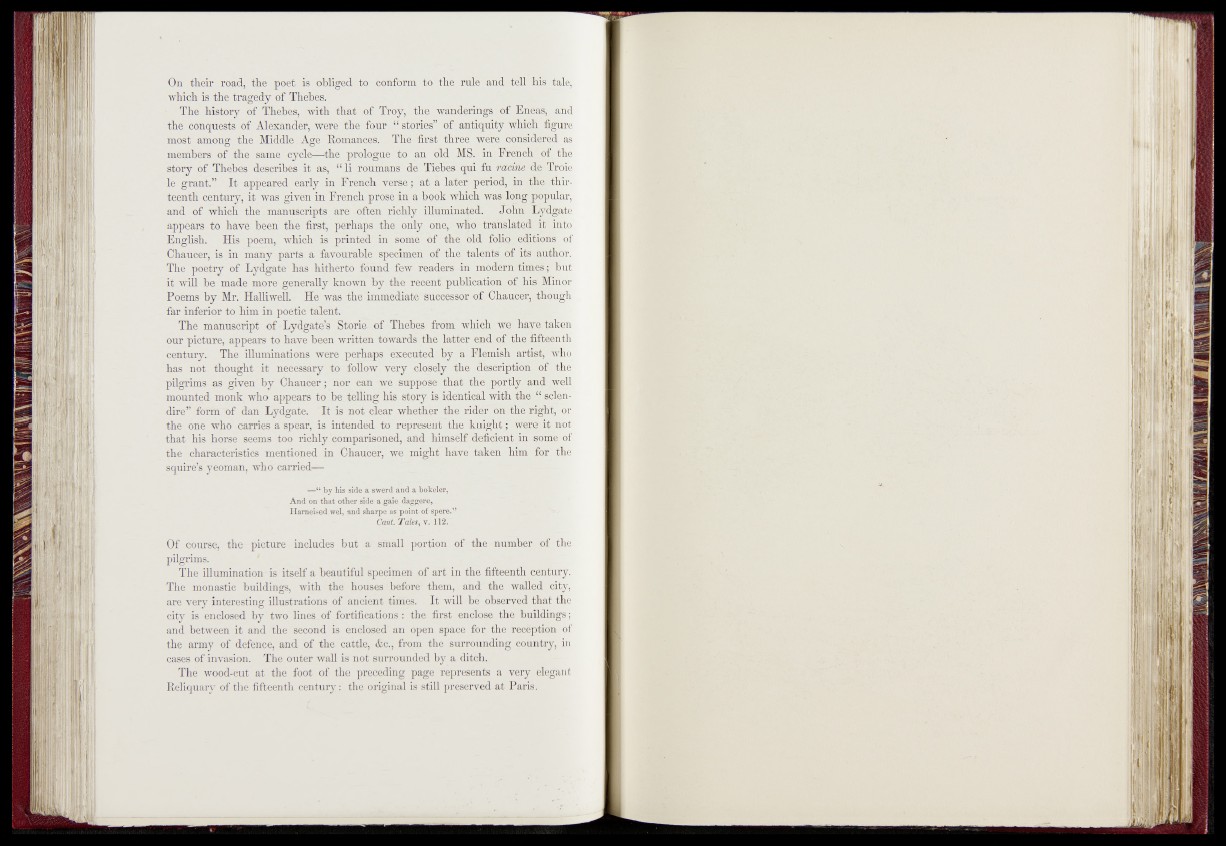
Ön their toad, the poet is obliged to ^<paföïm($!ó><tEè‘ rub* ancUjtell his tale,
which is the tragedy of Thebes'.-1
• The history SgThebes, with that -o f Troy, the wapd'erings^o|^heas, and
the conquests of, Alexander, .were 4he four i ‘ stories”,Jof-, antiquity^ which|||gure
most among the Middle I Age Romances. ® fe-first jtxÉix'eè. were Q'ónsidered as
members o f the same cy<Cé^—the" prologtle jfco an old MS.-im French,-M f,fee
story of Thebes describes it as, “ li f'oumaq&rie' Tiebes qui fu racme,'"d.@T|oië;
le grant.” It appeared early." ih-‘ French verse; at a latei? period, in. |Ke< thirteenth
century, it was given in French prosè in a book which was long^ippular,
iand of wEcË th e . manuscripts are ^often richly illuminated. John L e g a te
appears to have been the first, perhaps the-only one, who^téadSlatéd it into
Fnglish. His poena, which is printed fit some of the ol^^ofiq^ e® IK 4 'o f
Chaucer, is in many parts a favourable specimen of the talents of itsv^mor.
The poetry of Lydgate has hithèrto found few readers-in modern^jmes-; but
it w ill be made more generally known by the recent, publication bfrhisjMjhor
Poems by Mr. HalliwelL He was the-immediate successor Of- Chaucer, Jgj|ugb<
far inferior to him in poetic talent. -
The manuscript of - Lydgate’s Storie of Thebes from which we t hayMtaken
our picture, appears to have been written towards the latter end ofjmt^nfteentl1
century. The illuminations were perhaps executed by a Flemish artisj^^liu
has not thought p necessary to follow very closely the description .of me.
pilgrims as given hy Chaucer;" nor can we suppose that the’jpprtly. uua£iSpU
mounted monk, who appears to bestelling his story is identical with
dire” fornanbf dsn Lydgate. Tt is not clear-whether tbé rider on tbe right, or -
the one who carries a'Spear, is intended to represent the -knight} •^w.qre" it Kb
that his horse seems too richly comparisoned, and himself deficient in some- ol‘
the characteristics mentioned in Chaucer, wé might have taken him for the
squire’s yeoman, who carried—
—u by Ms side a swerd and a bokeler,
And on that other aider & gaie daggere,
Harneised.wel, and sharpe as point of spere.”
Cant. T a le s| y. 112.2
Of course, the-picture includes but a small portion of the number of a e
pilgrims.
The illumination is itself a beautiful specimen of art in the fifteenth cdptiiry.
The monastic buildings, with the houses before' them, and the walled city,
are very interesting illustrations of ancient times. It will be observed that the
city is enclosed by two lines„of fortifications: the first enclose the buildings;
and between it and the second is enclosed an open space for the reception of
the army of defence, and of the cattle, &c., from the surrounding country, in
cases of invasion. The outer wall is not surrounded hy a ditch.
The wood-cut at the foot of- the preceding page represents a very elegant
Reliquary of the fifteenth centuiy: the original is still preserved at Paris.